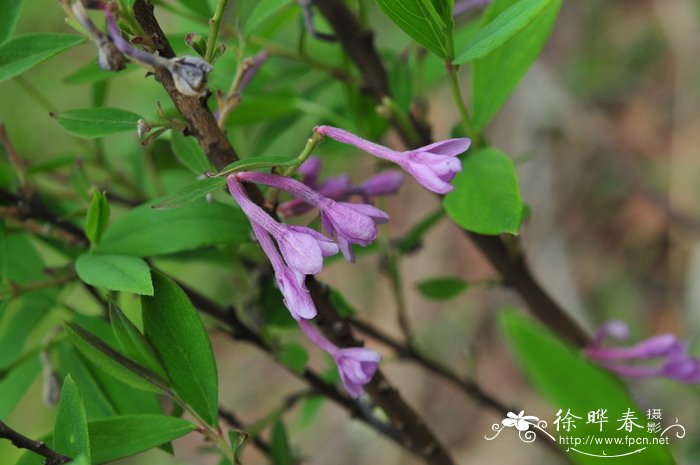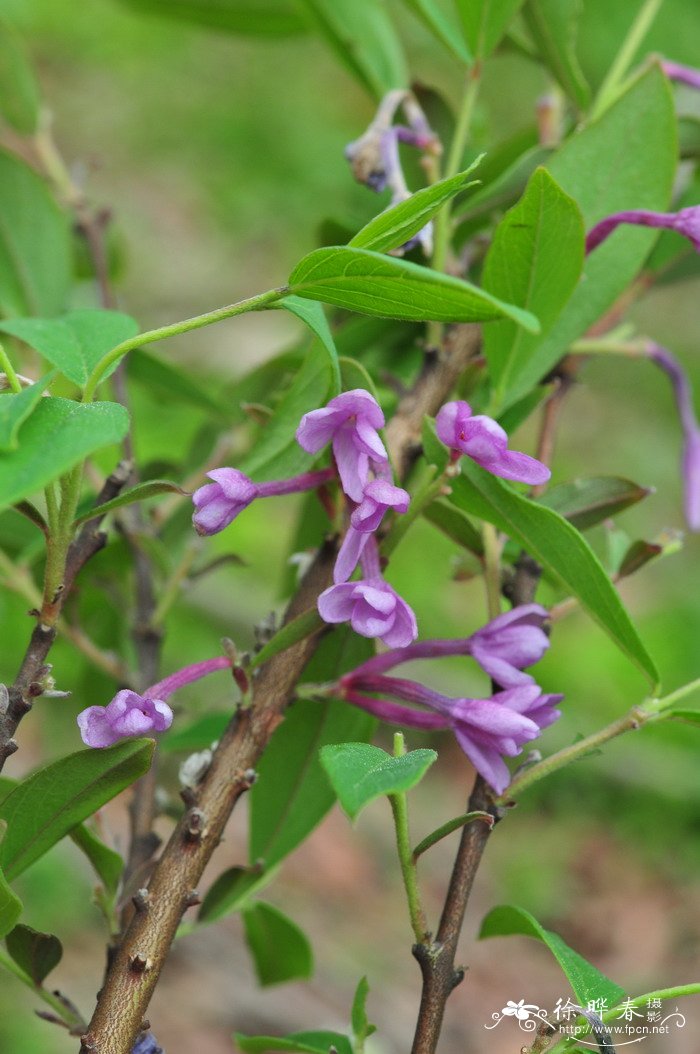芫花Daphne genkwa
中文名(Chinese Name):芫花
学名(Scientific Name):Daphne genkwa Sieb. et Zucc.
英文名(English Common Name):
别名(Chinese Common Name):荛花、药鱼草
异名(Synonym):Daphne genkwa var. fortunei (Lindl.) Franch. Daphne genkwa f. taitoensis Hamaya Wikstroemia genkwa (Siebold et Zucc.) Domke Daphne taitoensis Hamaya
科属(Family & Genus):瑞香科(Thymelaeaceae)瑞香属
形态特征(Description):落叶灌木,高0.3-1米,多分枝;树皮褐色,无毛;小枝圆柱形,细瘦,干燥后多具皱纹,幼枝黄绿色或紫褐色,密被淡黄色丝状柔毛,老枝紫褐色或紫红色,无毛。叶对生,稀互生,纸质,卵形或卵状披针形至椭圆状长圆形,长3-4厘米,宽1-2厘米,先端急尖或短渐尖,基部宽楔形或钝圆形,边缘全缘,上面绿色,干燥后黑褐色,下面淡绿色,干燥后黄褐色,幼时密被绢状黄色柔毛,老时则仅叶脉基部散生绢状黄色柔毛,侧脉5-7对,在下面较上面显著;叶柄短或几无,长约2毫米,具灰色柔毛。花比叶先开放,紫色或淡紫蓝色,无香味,常3-6朵簇生于叶腋或侧生,花梗短,具灰黄色柔毛;花萼筒细瘦,筒状,长6-10毫米,外面具丝状柔毛,裂片4,卵形或长圆形,长5-6毫米,宽4毫米,顶端圆形,外面疏生短柔毛;雄蕊8,2轮,分别着生于花萼筒的上部和中部,花丝短,长约0.5毫米,花药黄色,卵状椭圆形,长约1毫米,伸出喉部,顶端钝尖;花盘环状,不发达;子房长倒卵形,长2毫米,密被淡黄色柔毛,花柱短或无,柱头头状,橘红色。果实肉质,白色,椭圆形,长约4毫米,包藏于宿存的花萼筒的下部,具1颗种子。花期3-5月,果期6-7月。
分布(Distribution):产河北、山西、陕西、甘肃、山东、江苏、安徽、浙江、江西、福建、台湾、河南、湖北、湖南、四川、贵州等省,生于海拔300-1000米。
用途(Use):日本有栽培。观赏植物;花蕾药用,为治水肿和祛痰药,根可毒鱼,全株可作农药,煮汁可杀虫,灭天牛虫效果良好;茎皮纤维柔韧,可作造纸和人造棉原料。
引自中国植物志英文版:FOC Vol. 13 Page 231, 236, 239
Daphne genkwa Siebold & Zuccarini, Fl. Jap. 1: 137. 1835.
芫花 yuan hua| Thymelaeaceae | Daphne
Daphne fortunei Lindley; D. genkwa var. fortunei (Lind ley) Franchet; D. genkwa f. taitoensis Hamaya; Wikstroemia genkwa (Siebold & Zuccarini) Domke.
Shrubs deciduous, 0.3-1 m tall. Branches many, yellowish green or purplish brown, densely yellowish sericeous. Leaves opposite, subopposite, or alternate; petiole almost absent to 2 mm, gray pubescent; leaf blade ovate, ovate-lanceolate, or elliptic-oblong, 3-4(-6) × (0.5-)1-2 cm, papery, abaxially sericeous, base broadly cuneate or rounded, apex acute or shortly acuminate; lateral veins 5-7 pairs. Inflorescences mostly lateral, produced before leaves, less often terminal on long shoots or axillary, 3-7(-15)-flowered; peduncle usually very short, better developed on later inflorescences. Flowers not fragrant; pedicel short, grayish yellow pubescent. Calyx bluish purple, lilac, or lavender; tube cylindric, 6-11 mm, slender, exterior sericeous; lobes 4, ovate or oblong, 5-6(-10) × ca. 4 mm, abaxially puberulous, apex rounded. Stamens 8, lower whorl inserted at middle of calyx tube, upper whorl below throat; filaments short; anthers ovoid-ellipsoid, ca. 1 mm, upper ones partly exserted from calyx tube; disk annular. Ovary obovoid, ca. 2 mm, densely yellow pubescent; style short or absent; stigma capitate. Drupe white to reddish, black when dry, ellipsoid, ca. 4 mm, enclosed in persistent calyx. Fl. Mar-May, fr. Jun-Jul.
Forests, shrubby slopes; 300-1000 m. Anhui, Fujian, Gansu, Guizhou, Hebei, Henan, Hubei, Hunan, Jiangsu, Jiangxi, Shaanxi, Shandong, Shanxi, Sichuan, Taiwan, Zhejiang [Korea].
Daphne genkwa is a popular garden plant that can usually be easily identified by the precocious inflorescences of distinctively colored flowers (the "lilac daphne"), produced on very reduced lateral shoots such that they superficially appear to be axillary. However, it seems that there is sometimes a second flush of flowers produced later in the season, after the leaves, when the inflorescences are often pedunculate and sometimes axillary as well as clearly terminal, sometimes on long shoots. The leaf arrangement is very variable. The species is valued horticulturally, while the dried flower buds are used medicinally.


(责任编辑:徐晔春)
学名(Scientific Name):Daphne genkwa Sieb. et Zucc.
英文名(English Common Name):
别名(Chinese Common Name):荛花、药鱼草
异名(Synonym):Daphne genkwa var. fortunei (Lindl.) Franch. Daphne genkwa f. taitoensis Hamaya Wikstroemia genkwa (Siebold et Zucc.) Domke Daphne taitoensis Hamaya
科属(Family & Genus):瑞香科(Thymelaeaceae)瑞香属
形态特征(Description):落叶灌木,高0.3-1米,多分枝;树皮褐色,无毛;小枝圆柱形,细瘦,干燥后多具皱纹,幼枝黄绿色或紫褐色,密被淡黄色丝状柔毛,老枝紫褐色或紫红色,无毛。叶对生,稀互生,纸质,卵形或卵状披针形至椭圆状长圆形,长3-4厘米,宽1-2厘米,先端急尖或短渐尖,基部宽楔形或钝圆形,边缘全缘,上面绿色,干燥后黑褐色,下面淡绿色,干燥后黄褐色,幼时密被绢状黄色柔毛,老时则仅叶脉基部散生绢状黄色柔毛,侧脉5-7对,在下面较上面显著;叶柄短或几无,长约2毫米,具灰色柔毛。花比叶先开放,紫色或淡紫蓝色,无香味,常3-6朵簇生于叶腋或侧生,花梗短,具灰黄色柔毛;花萼筒细瘦,筒状,长6-10毫米,外面具丝状柔毛,裂片4,卵形或长圆形,长5-6毫米,宽4毫米,顶端圆形,外面疏生短柔毛;雄蕊8,2轮,分别着生于花萼筒的上部和中部,花丝短,长约0.5毫米,花药黄色,卵状椭圆形,长约1毫米,伸出喉部,顶端钝尖;花盘环状,不发达;子房长倒卵形,长2毫米,密被淡黄色柔毛,花柱短或无,柱头头状,橘红色。果实肉质,白色,椭圆形,长约4毫米,包藏于宿存的花萼筒的下部,具1颗种子。花期3-5月,果期6-7月。
分布(Distribution):产河北、山西、陕西、甘肃、山东、江苏、安徽、浙江、江西、福建、台湾、河南、湖北、湖南、四川、贵州等省,生于海拔300-1000米。
用途(Use):日本有栽培。观赏植物;花蕾药用,为治水肿和祛痰药,根可毒鱼,全株可作农药,煮汁可杀虫,灭天牛虫效果良好;茎皮纤维柔韧,可作造纸和人造棉原料。
引自中国植物志英文版:FOC Vol. 13 Page 231, 236, 239
Daphne genkwa Siebold & Zuccarini, Fl. Jap. 1: 137. 1835.
芫花 yuan hua| Thymelaeaceae | Daphne
Daphne fortunei Lindley; D. genkwa var. fortunei (Lind ley) Franchet; D. genkwa f. taitoensis Hamaya; Wikstroemia genkwa (Siebold & Zuccarini) Domke.
Shrubs deciduous, 0.3-1 m tall. Branches many, yellowish green or purplish brown, densely yellowish sericeous. Leaves opposite, subopposite, or alternate; petiole almost absent to 2 mm, gray pubescent; leaf blade ovate, ovate-lanceolate, or elliptic-oblong, 3-4(-6) × (0.5-)1-2 cm, papery, abaxially sericeous, base broadly cuneate or rounded, apex acute or shortly acuminate; lateral veins 5-7 pairs. Inflorescences mostly lateral, produced before leaves, less often terminal on long shoots or axillary, 3-7(-15)-flowered; peduncle usually very short, better developed on later inflorescences. Flowers not fragrant; pedicel short, grayish yellow pubescent. Calyx bluish purple, lilac, or lavender; tube cylindric, 6-11 mm, slender, exterior sericeous; lobes 4, ovate or oblong, 5-6(-10) × ca. 4 mm, abaxially puberulous, apex rounded. Stamens 8, lower whorl inserted at middle of calyx tube, upper whorl below throat; filaments short; anthers ovoid-ellipsoid, ca. 1 mm, upper ones partly exserted from calyx tube; disk annular. Ovary obovoid, ca. 2 mm, densely yellow pubescent; style short or absent; stigma capitate. Drupe white to reddish, black when dry, ellipsoid, ca. 4 mm, enclosed in persistent calyx. Fl. Mar-May, fr. Jun-Jul.
Forests, shrubby slopes; 300-1000 m. Anhui, Fujian, Gansu, Guizhou, Hebei, Henan, Hubei, Hunan, Jiangsu, Jiangxi, Shaanxi, Shandong, Shanxi, Sichuan, Taiwan, Zhejiang [Korea].
Daphne genkwa is a popular garden plant that can usually be easily identified by the precocious inflorescences of distinctively colored flowers (the "lilac daphne"), produced on very reduced lateral shoots such that they superficially appear to be axillary. However, it seems that there is sometimes a second flush of flowers produced later in the season, after the leaves, when the inflorescences are often pedunculate and sometimes axillary as well as clearly terminal, sometimes on long shoots. The leaf arrangement is very variable. The species is valued horticulturally, while the dried flower buds are used medicinally.
(责任编辑:徐晔春)
踩一下[0]

顶一下[1]